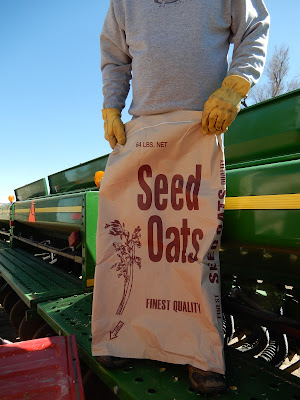Today is Ag Day 2019. It's a day set aside to celebrate agriculture's role in American life.
Most of my blog posts tell about our efforts on The County Line to provide food, fuel and fiber for American families and consumers throughout the world. As I've said before, it's Ag Day
every day around here.
Of course, we believe agriculture is important. We wouldn't be the fifth
generation of farmers in our respective families if we didn't believe in
agriculture.
As our society moves away from its agrarian roots, fewer
people seem to recognize the value. Sadly, one of the members of a
Facebook Farmers Wives group posted this message on Tuesday:
People
never cease to amaze me! I was told today that we didn't need farmers!!
So I am guessing that person doesn't need to eat either.
As
organizers of Ag Day say:
We know that food and fiber doesn't just
arrive at the grocery or clothing store or magically appear on the
dinner table or in our closet. There's an entire industry dedicated to
providing plentiful and safe food for consumption.
- Each American farmer feeds about 165 people. Agriculture is America's No. 1 export.
- New technology means farmers are more environmentally friendly than ever before.
As the Ag Week hashtags and Facebook posts have been showing up on my social media feed this week, I've been thinking more about the importance of rural communities - actually
being a community.
This
week, a community matriarch and business owner in our small town died after a long
illness. One of her grandsons posted a thank you for the expressions of
sympathy given to their family - everything from cards to prayers to
meals.
And, on the other end of the spectrum, two of
our community's veterinarians had their first baby. He lived only two
hours. A Meal Train is filling up quickly, and a fund to help them pay
for medical and funeral expenses has already exceeded the original goal.
Helping
out a neighbor is second nature to rural communities. It's demonstrated
over and over and over again. Those are just two of latest examples. It wouldn't take me long to come up with a dozen.
For
more than 100 years, each of our families has had pasture lands as part
of our farming operations.We are caretakers for other pastures that have had a similar legacy in our landlords' families.
For grazing to be abundant, a pasture
requires several different species of grass - from big bluestem to
little bluestem to Indian grass to brome to Forbes (just to name a
few).
These grasses all have different heights. Some
mature early; others later. Those different species end up working together to keep the
soil in place, reduce erosion and provide nourishment for grazing
animals.
It's like that in a community, too. We're all
different. We all have different abilities and interests and God-given
talents. But it's that "hanging together" that makes a healthy
environment.
That symbiosis is demonstrated day after day, week after
week, year after year in a rural community: It may be helping an ailing
neighbor harvest a crop. It might be baking a pan of cheesy potatoes for a funeral dinner. It could be working at the Food Bank. It might be serving on a church or community board.
That's not to say that rural life is idyllic. It can be just as stressful as that job in the downtown skyscraper - and probably not as profitable most years. Challenges come - no matter your address. As I've written this the past two days, the wind has been howling with 50-mile-per-hour-plus gusts, and we've had another 1.10 of rain we don't need. Believe me, there are challenges.
But those trials can strengthen us and our resolve, too. It's kind of like a Flint Hills pasture in the spring. It won't be long before "smoke signals" will drift into the Kansas skies from controlled burns on Kansas pasture lands, especially in the Flint Hills.
We think of fire as a destructive thing, and it certainly can be. But it can also be a vehicle of rebirth. One spring, I stopped at the Tallgrass Prairie National Preserve south of
Council Grove - a detour as I came home from a convention. I could see the remnants of a prairie fire in the charred
grasses and scorched branches.

But from the charred earth was green regrowth and vibrant prairie flowers lifting toward a vibrant blue sky.

It seems counter intuitive. Why would fire - which seems such a destructive force - bring this new life?

Yet as ranchers light fires to clear the dead grass and small brush, it makes way for a new carpet of green just weeks later.

And
the cycle of life begins again. The Flint Hills are part of the
tallgrass prairie, which stretches from Canada to Texas. Ranchers have a
saying: Take care of the grass and it will take care of you. Burning
pastures has been part of caring for the prairie even back to the days
of the Indians. It's an age-old partnership with cattle, birds,
wildflowers and the grasslands.
The same can be said of our rural communities. There are challenges and tragedies and things we must overcome.
But figuring out how to survive those things and come out on the other side stronger together is the true mark of community. And, in my experience, the ag community does that as well - or better - than any.
Happy Ag Day!

















































